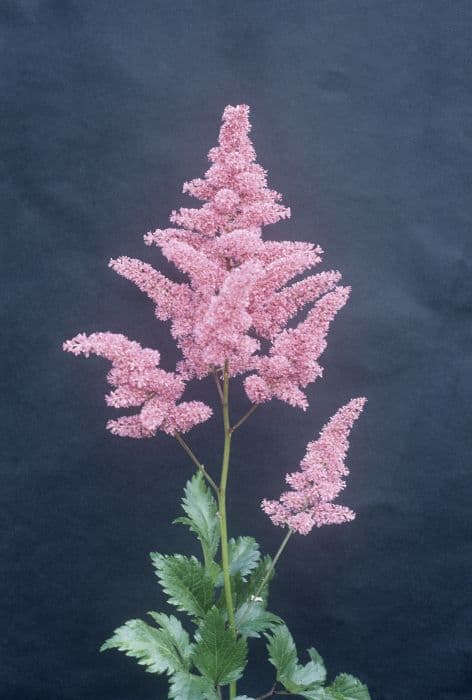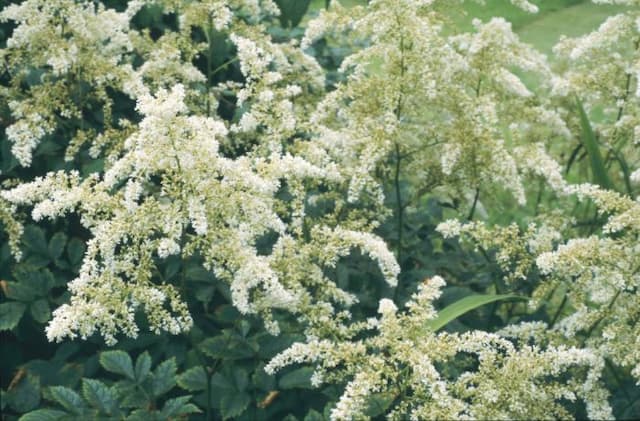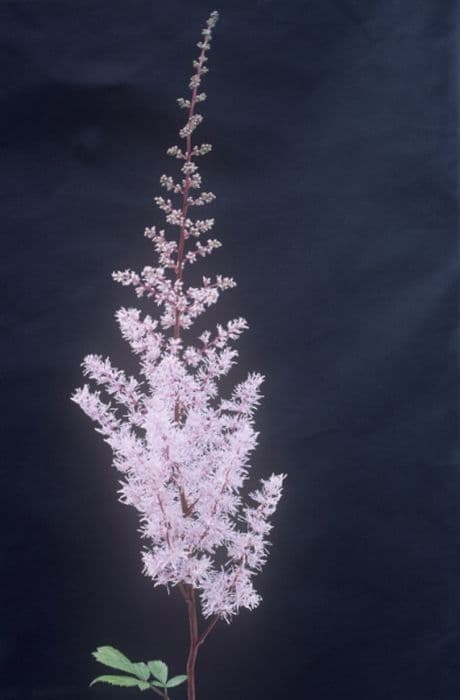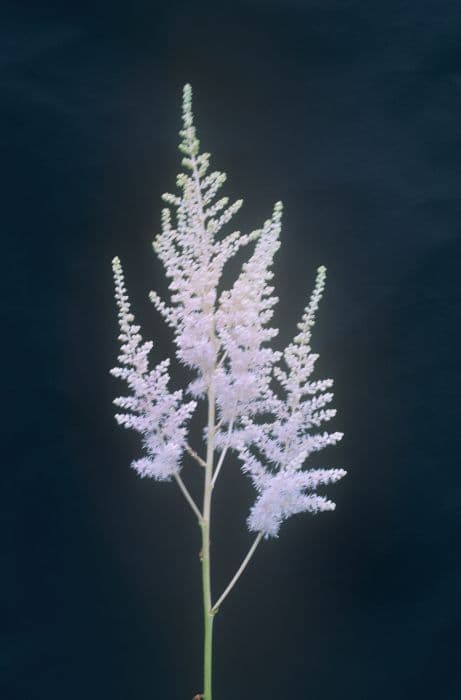False Spirea Astilbe 'Red Sentinel' (japonica hybrid)

ABOUT
Astilbe 'Red Sentinel' is known for its striking appearance, with vivid, fluffy plumes of tiny, intensely red flowers forming a dense, feathery spike that adds a burst of color to any garden setting. These flower spikes arise gracefully above a lush mound of deep green foliage. The leaves are intricately divided and fern-like, providing a beautiful texture contrast to the softness of the blooms. The foliage has a glossy sheen and can sometimes have a bronze hue, further enhancing the visual appeal of the plant. This charming perennial is a favorite for its bright show of color and its ability to add both vertical and textural interest without overwhelming a space with its size.
About this plant
 Names
NamesFamily
Saxifragaceae
Synonyms
False Goat's Beard, False Spirea
Common names
Astilbe japonica 'Red Sentinel'.
 Toxicity
ToxicityTo humans
Astilbe is generally considered non-toxic to humans. There is no notable toxicity that would cause concerning symptoms upon ingestion. As with any non-food plant, consuming large amounts of Astilbe could potentially cause mild stomach upset due to the plant matter not being part of the typical diet.
To pets
Astilbe is also generally recognized as non-toxic to pets such as dogs and cats. It does not contain any known toxins that would cause serious illness or symptoms typical of poisoning. However, similar to humans, if pets ingest large quantities of the plant, they might experience minor gastrointestinal discomfort, such as vomiting or diarrhea, simply because it is not a regular part of their diet.
 Characteristics
CharacteristicsLife cycle
Perennials
Foliage type
Deciduous
Color of leaves
Green
Flower color
Red
Height
2 feet (60 cm)
Spread
2 feet (60 cm)
Plant type
Herb
Hardiness zones
4
Native area
Japan
Benefits
 General Benefits
General Benefits- Attractive Flowers: Astilbe 'Red Sentinel' boasts vibrant, feathery plumes of red flowers that add striking color and texture to garden spaces.
- Shade Tolerance: This plant is known for its ability to thrive in partial to full shade, making it ideal for underplanting in woodland gardens or shaded areas where other plants may struggle.
- Low Maintenance: It requires minimal care once established, with little need for pruning or deadheading, making it suitable for gardeners of all skill levels.
- Deer and Rabbit Resistant: Its foliage is unappealing to deer and rabbits, helping to prevent damage from these common garden pests.
- Pollinator Friendly: The flowers of the Astilbe 'Red Sentinel' attract beneficial insects, such as butterflies and bees, which are vital for pollination in the garden ecosystem.
- Seasonal Interest: In addition to its summer blooms, this plant provides visual interest with its changing foliage in the fall, making it an excellent choice for year-round gardens.
- Erosion Control: Astilbe has a robust root system that helps to stabilize soil and prevent erosion in sloped or moist garden areas.
- Drought Resistance: Once established, it can tolerate periods of drought, although it prefers consistently moist soil conditions.
- Container Gardening: Its compact size and attractive foliage make it suitable for container gardening, providing flexibility in garden design and use of space.
- Mass Planting Appeal: When planted in groups or masses, Astilbe 'Red Sentinel' creates a lush, textured display that can serve as a ground cover or a backdrop for other plants in a garden bed.
 Medical Properties
Medical PropertiesThis plant is not used for medical purposes.
 Air-purifying Qualities
Air-purifying QualitiesThis plant is not specifically known for air purifying qualities.
 Other Uses
Other Uses- Photography Prop: Astilbe 'Red Sentinel' with its vibrant red blooms can be used as a striking subject or backdrop for photography, enhancing floral and garden-themed photo shoots.
- Natural Dye: The deep red flowers of the plant can be used to create natural dyes for fabric, yarn, or paper, providing a sustainable alternative to synthetic dyes.
- Educational Tool: Astilbe 'Red Sentinel' can serve as a live specimen for botany or horticulture classes, showcasing plant structure, growth, and hybrid characteristics.
- Artistic Inspiration: Artists may use the plant's unique form and color as inspiration for paintings, drawings, or other art forms, capturing the beauty of natural flora.
- Dried Arrangements: The flowers of Astilbe 'Red Sentinel' can be dried and used in everlasting floral arrangements, adding texture and color that persists year-round.
- Floral Crafts: The stems and flowers can be incorporated into floral crafts such as wreaths or garlands, especially for autumn and winter-themed decorations.
- Wedding Decor: Its striking red plumes can be used in wedding bouquets, centerpieces, or venue decorations, contributing to a romantic and elegant ambiance.
- Fish Tank Decoration: After ensuring non-toxicity, the robust stems of the plant could potentially be used as a natural decoration in freshwater aquariums.
- Soil Erosion Control: When planted in groups, Astilbe 'Red Sentinel' can help prevent soil erosion in gardens due to its dense root system and foliage.
- Privacy Screen: The plant can be grown in clusters to form a low, natural privacy screen in gardens or on patios during its growing season.
Interesting Facts
 Feng Shui
Feng ShuiThe Astilbe is not used in Feng Shui practice.
 Zodiac Sign Compitability
Zodiac Sign CompitabilityThe Astilbe is not used in astrology practice.
 Plant Symbolism
Plant Symbolism- Patience: Astilbes take time to grow and flourish, representing the virtue of patience in personal growth and relationships.
- Perseverance: As shade-loving plants that thrive in difficult growing conditions, astilbes symbolize persistent effort and resilience.
- Hope: The lush and feathery plumes of the astilbe plant are often seen as a symbol of hope and optimism for the future.
- Devotion: The plant's tendency to grow in dense clusters symbolizes close-knit relationships and a dedication to loved ones.
 Water
WaterFalse Spirea should be kept evenly moist, so water the plant deeply once or twice a week, depending on weather conditions. Ensure that the soil doesn't dry out; applying about one gallon of water for each watering session should suffice. In the heat of summer, the plant may require more frequent watering, especially if the weather is particularly hot and dry. Conversely, reduce watering frequency during cool, wet periods to prevent root rot. Consistent moisture is key for the best growth and flower production.
 Light
LightFalse Spirea thrives best in partial shade, particularly in the hot afternoon hours. It can tolerate full sun in cooler climates, but in hotter regions, it prefers some protection from intense midday rays. The ideal spot for planting False Spirea is an area with morning sun and afternoon shade, providing a balance of light without the harsh effects of direct, strong sunlight all day.
 Temperature
TemperatureFalse Spirea is hardy and can tolerate a range of temperatures once established. It performs well in temperatures between 60°F and 75°F, which are ideal growing conditions. The plant can survive minimum temperatures down to about -20°F and maximum temperatures up to around 80°F, beyond which it may begin to show signs of heat stress.
 Pruning
PruningPrune False Spirea to maintain its shape and encourage denser growth. The best time for pruning is in late winter or early spring, just before new growth starts. Cut back the spent flower stalks after blooming to tidy the plant and potentially encourage a second bloom. Every few years, it can be beneficial to cut back the entire plant to ground level in early spring to rejuvenate and promote vigorous growth.
 Cleaning
CleaningAs needed
 Soil
SoilAstilbe 'Red Sentinel' thrives in rich, moist, well-draining soil with a pH of 6.0 to 7.0. A mix of garden soil, compost, and peat moss is ideal to retain moisture and provide nutrients. Mulching helps maintain soil conditions.
 Repotting
RepottingThe Astilbe 'Red Sentinel' generally does not need frequent repotting; it can be divided every 3-4 years during the spring to rejuvenate and spread the plant.
 Humidity & Misting
Humidity & MistingAstilbe 'Red Sentinel' prefers high humidity levels but is adaptable and can thrive in average garden humidity conditions.
 Suitable locations
Suitable locationsIndoor
Keep Astilbe 'Red Sentinel' in moist soil, indirect light, high humidity.
Outdoor
Plant Astilbe 'Red Sentinel' in part shade, moist soil, mulch well.
Hardiness zone
4-8 USDA
 Life cycle
Life cycleAstilbe 'Red Sentinel', commonly known as False Goat's Beard, begins its life cycle when the seeds are sown into moist, well-drained soil, typically in early spring or by division of rhizomes. After germination, seedlings emerge and mature into clumps of fern-like foliage. Throughout spring and into early summer, the plant focuses energy on leaf development, forming a dense mound of foliage. As temperatures rise, plume-like flower spikes begin to emerge and bloom, displaying vivid red flowers that attract pollinators and provide a striking display in the garden. After flowering, usually in late summer, the plant sets seeds, which can be collected for propagation or left to self-sow. With the onset of fall and colder weather, Astilbe 'Red Sentinel' dies back to the ground, with the roots and rhizomes remaining dormant over winter, ready to regrow the following spring.
 Propogation
PropogationPropogation time
Spring to Summer
The Astilbe 'Red Sentinel', a beautiful japonica hybrid, is most commonly propagated by division. To propagate Astilbes by division, the process should ideally be carried out in the spring when the plant is emerging from dormancy or in the fall after the blooming period has ended. A gardener should gently lift the whole clump from the ground using a shovel or fork, taking care not to damage the root system. Once lifted, the clump can be divided into smaller sections using a sharp knife or spade, making sure that each section has at least 2-3 growth points or buds. These sections are then replanted at the same soil depth they were previously growing, spaced approximately 18 inches (roughly 45 centimeters) apart to allow ample room for growth. The newly planted divisions should be watered thoroughly to establish them in their new locations. This method is highly favored as it not only propagates new plants but also helps rejuvenate older clumps that may have become woody or less vigorous over time.









